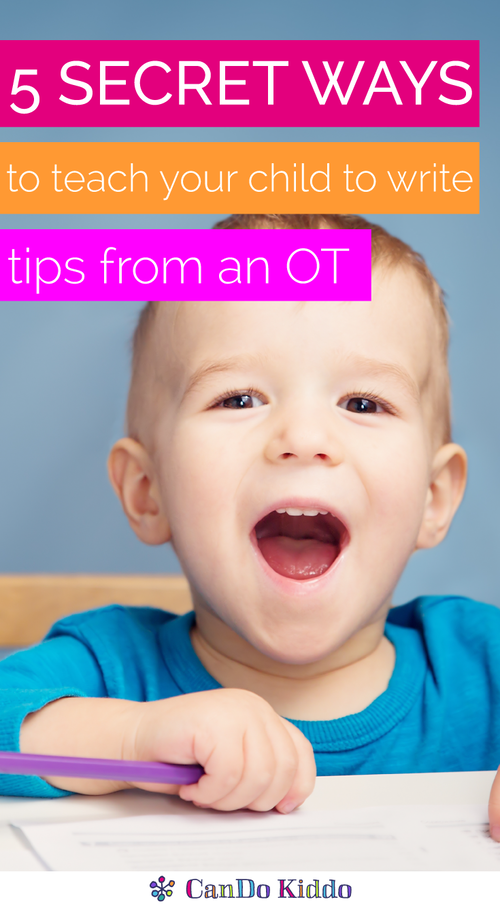I’m letting you in on what learning-to-write experts (pediatric Occupational Therapists) know about supporting early writing skills. What’s on this list might surprise you because it includes activities that don’t directly appear related to writing at all! That’s one of the most powerful secrets parents can learn - that toddlers aren’t ready for specific writing instruction.
Support your toddler’s writing skills by meeting them RIGHT where they are developmentally RIGHT NOW. Let’s take a look at what your toddler is developmentally ready for that will support writing skills in the years to come…
Developmental Toddler Play To Support Writing 🔗

Active Play 🔗
Climbing, sliding, swinging, hanging, pushing, pulling, digging, jumping, rolling, and running: these are all ways that your child develops the strength, coordination, sensory processing, and self-regulation skills for reading and writing. Outside is best (nature supports sensory regulation), but there are certainly ways to do active play indoors (follow my Pinterest board for ideas).
Exposure to Print Materials 🔗
Read books together every day, and go to a public library weekly if you have one available. Let your child see you read - books, magazines, and the newspaper. Don’t stress if you don’t have an adorable book nook or trendy reading teepee in your home - a kid-accessible book basket or shelf and a floor, couch or lap work just fine.
Play With Manipulatives 🔗
Little toddler hands are not ready for the grasping, visual and coordination skills needed to write letters or detailed pictures. The best way to support them gaining those skills is through play with manipulatives.
Duplo Lego, stringing beads, play-doh, kinetic sand, puzzles, stickers, doll babies with clothes to take off and put on, Magnatiles, and my toddler’s favorite - "little guys” to put in rescue vehicles - are all perfect examples of open-ended toys that encourage the hand-eye coordination and hand strength needed for writing.
Exposure To Writing Tools 🔗
Drop the pre-academic skills educational agenda and just let your kiddo scribble, paint and explore writing tools and the marks they make. Developmentally toddlers are learning to make simple pre-writing marks - vertical and horizontal lines and circles.
The classic choice is crayons. But writing tools also include paint brushes, sidewalk chalk, Do a Dot markers, Magnadoodle boards, Water Wow paint-free painting pages, and even a stick to draw roads in the sandbox. Make these items available for your kiddo to get creative with.
Follow Your Child’s Interests 🔗
Some kiddos will start to recognize letters at 2 years old and show an interest in the world of letters and numbers. I remember my son asking what every.single.construction.sign said at that age. Other kiddos won’t have much interest in letters and numbers until closer to 4 or 5. Both are okay. Seriously. Whatever your toddler’s interest level is in writing is OKAY.
The beauty of this list is that it fits all levels of interest in writing. Have a kid who would rather chase a ball or play trucks? That’s active play and play with manipulatives. Have a kiddo who loves art and just makes scribbles? Sweet, they’re getting some amazing exposure to writing tools. Does your child have a passion for animals? Reading books about animals is supporting writing skills.
Here’s the thing…
Playtime or Writing Time? BOTH 🔗
At their young ages, I take a very unstructured, child-led approach to teaching typically developing kiddos. I trust children to learn to write and read when they’re ready by following their interests and passions. I respect play and connection as the most valuable means for learning.
Both clinically as an OT and as a mom, I’ve seen that young kiddos learn better from hands-on play than from technology or structured, seated work.
One set of learning tools I’m grateful to have in my house are from Fundanoodle, an educational readiness program that was designed by two Occupational Therapists (and fellow mamas) I used to work with. If you’ve read here long, you know I don’t do “sponsored posts” or get paid to endorse products. But when I love something, I happily share it! And since some of my OT friends are the creators of Fundanoodle and others are Fundanoodle Ambassadors, our house is well stocked with Fundanoodle gifts.
Fundanoodle products fit perfectly into our playtimes, and they incorporate all 5 of the secrets I just described. As I use them with my kiddos, I can TELL these products were designed by developmental experts.
12 Ways To Play 🔗
To show you how playful and unstructured we are in our explorations of letters and writing, here are 12 silly and educational ways we play and learn with Fundanoodle’s products:

Letters In A Tunnel 🔗
Mommy makes a letter sound and then says the name of a letter. Then toddler finds the letter from 4-8 letter cards on the ground and then carries it through a play tunnel to Mommy. With practice, sometimes the letter sound is all that’s needed.
Guess The Animal 🔗
Mommy makes the initial letter sound and movement of an animal on one of the Muscle Mover cards. Then toddler stomps on the card spread out on the floor in a small group.
Erase Mommy’s Letters On Dry Erase Board 🔗
Mommy slowly writes a letter on the dry erase board talking through the strokes using their Fundanoodle names like “zip” and “zoom.” Then Mommy excitedly shows toddler, who uses the eraser end of the dry erase marker to erase the letter - (sometimes using similar writing strokes and sometimes a frantic scribble). Then Mommy pretends very dramatically to be sad or shocked because toddlers and preschoolers LOVE a good dose of drama in their play and are learning how to read the nonverbal communication of others.
Building Letters 🔗
Construction worker dress-up clothes optional. Toddler picks a letter card (our blueprint/ plan for construction) and find the “building supplies” that Mommy asks for (“I need a short pink piece of wood and a little green curve”). Then Mommy puts letters pieces on the magnet board to build the letter and toddler secures them by hammering and using various other very important tools. There are high fives and smiles until an earthquake (hurricane, flood or other natural disaster) knocks the pieces off the board and we have to rebuild a new letter.
Building Pictures 🔗
We definitely don’t just stick to building letters with the magnet pieces. Since the magnet board is STRONG and really tough for toddler to pull pieces off of, we put them on the floor and make people, animals, and all sorts of pictures. I’ve attempted to build just about anything toddler can think of (water towers are my favorite request), and toddler has fun building, too.
DIY Dry Erase Activities 🔗
What started as an attempt for this budget conscious mama to re-use pages from our giant activity book, also turned out to be great for handwriting development. I taped the pages to the inside of our glass front door and let toddler use a dry erase marker. Writing on a vertical surface like this helps little ones learn to bend their wrists back as they hold a writing tool - an important position for handwriting. It also promotes shoulder strengthening.
Stack Up Wood 🔗
Sometimes we “stack up wood” by matching and sorting like sizes and colors of magnetic pieces. This is a great way to include color and size recognition into play.
Toddler Teacher 🔗
Using the dry erase board and marker or the magnetic pieces on the floor, toddler makes a picture and Mommy has to copy it and then submit it to the toddler teacher for critique. I mean, what toddler doesn’t LOVE being the boss!
Letter Frog Hop 🔗
We use our number frog bean-bags but any bean-bag-type object will do. We spread Muscle Mover Cards all over the floor (sometimes the whole set of 26) letter-side up. We sit on the couch and toss bean bags down onto the letters. We (usually Mommy first and Toddler repeating) excitedly announce what letters get landed on.
Magnetic Road 🔗
Those magnetic letter pieces are great for building a long and winding road for little cars or little people to travel on. It’s a fun way to engage with manipulatives and to reinforce the names of the writing strokes (you can use the Fundanoodle names).
Haircuts 🔗
A few of the activity pages in the I Can Cut! activity book depict a character with long hair and a dotted line across the hair for cutting. This concept was sooooo hilarious to Toddler that now a favorite activity is Mommy drawing a face with crazy long hair and toddler cutting it. Even more fun is when Mommy then acts out a dramatic response or critique (“OH NO!!! It’s so short. How will I ever put it in a ponytail again!” or “Wow - this is the fanciest haircut I’ve seen. Thank you! Thank you! Can you cut my friend’s hair like this?”) (use safety scissors)



